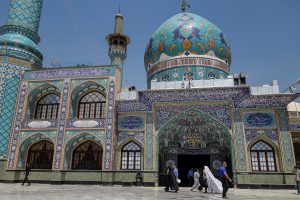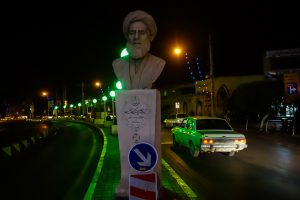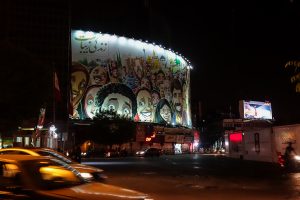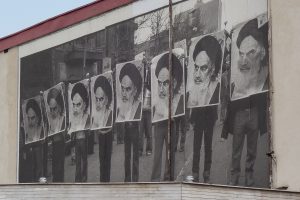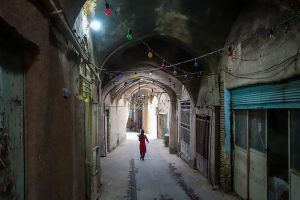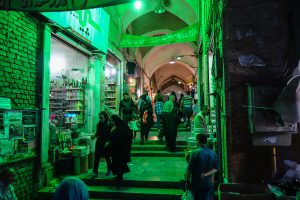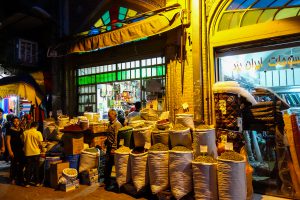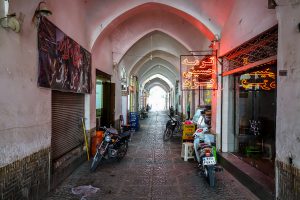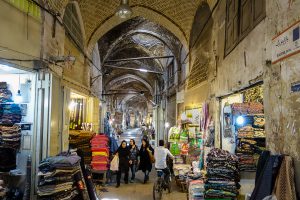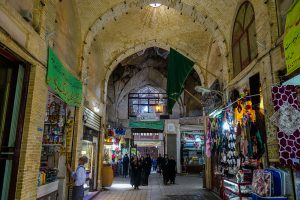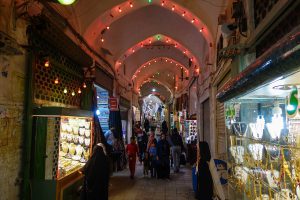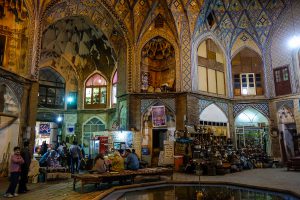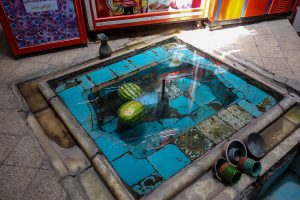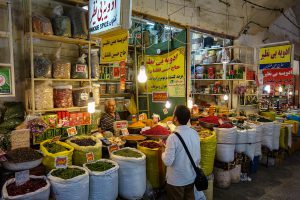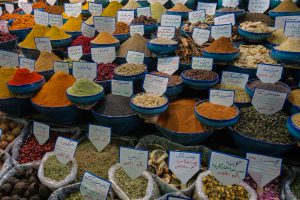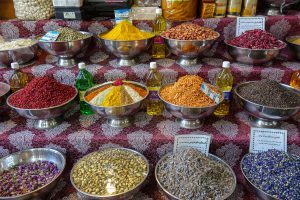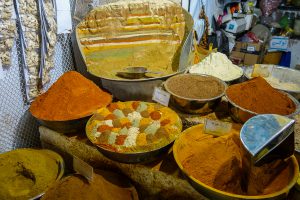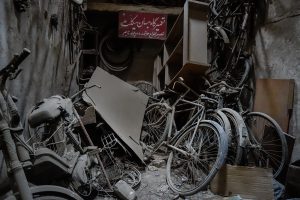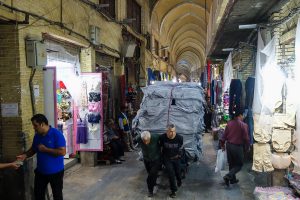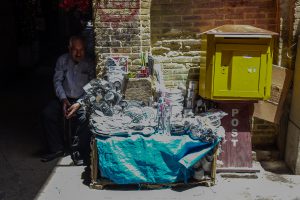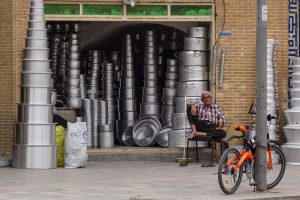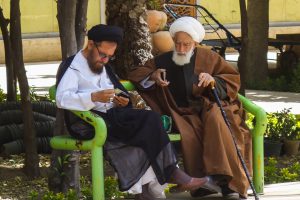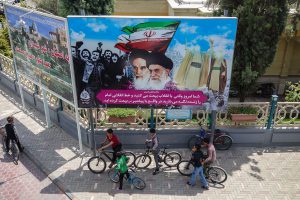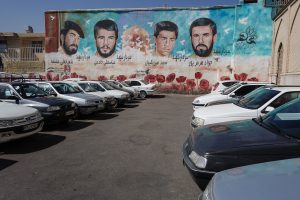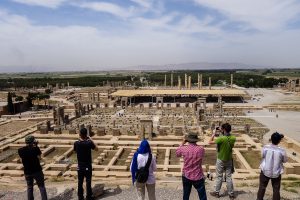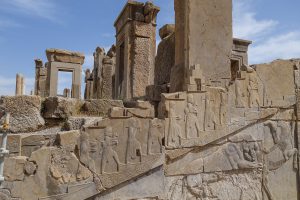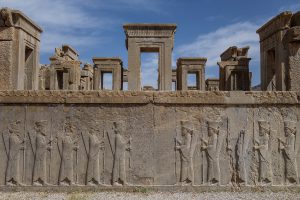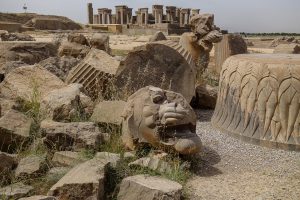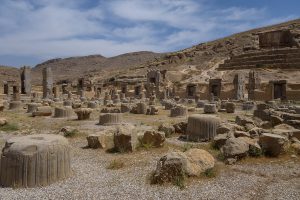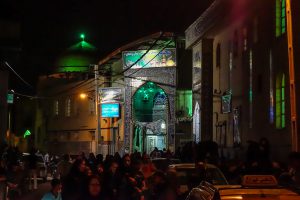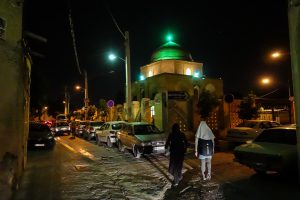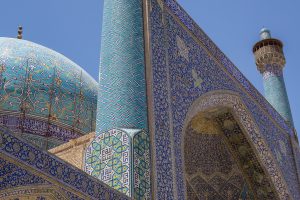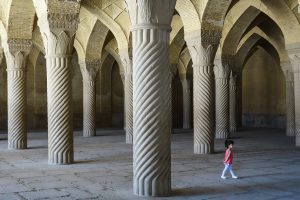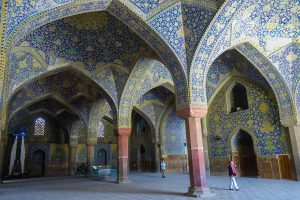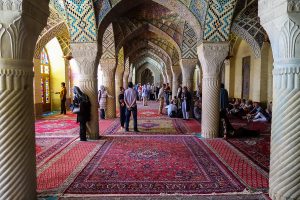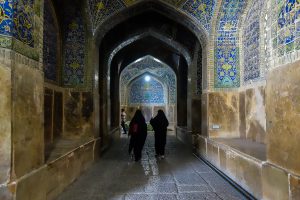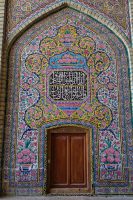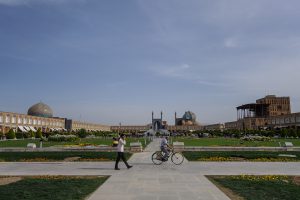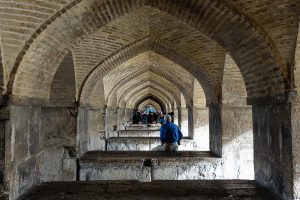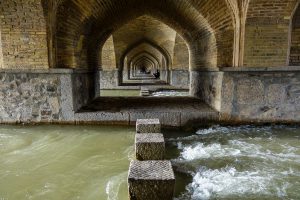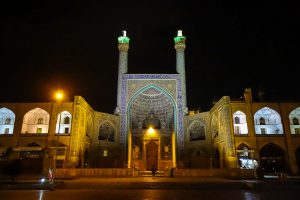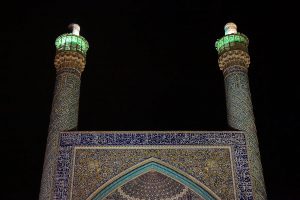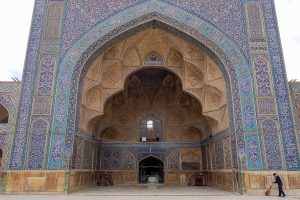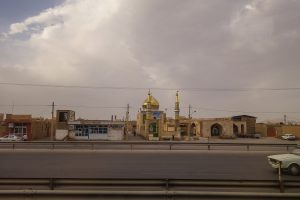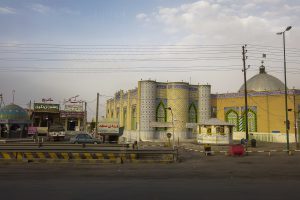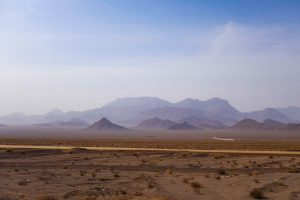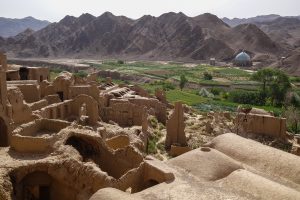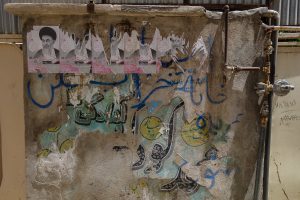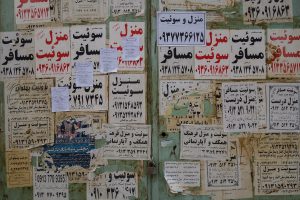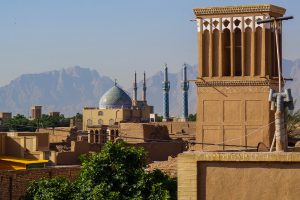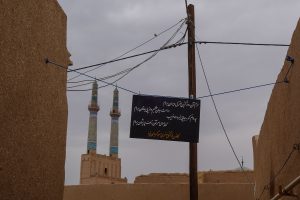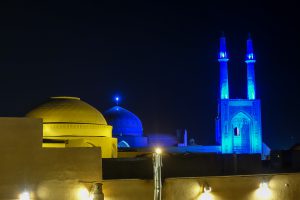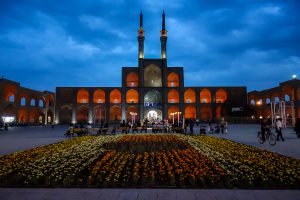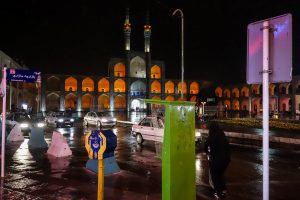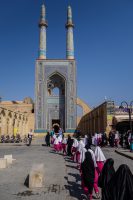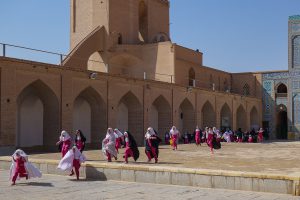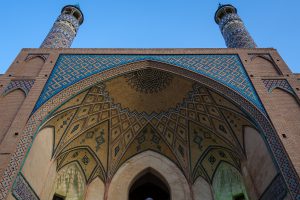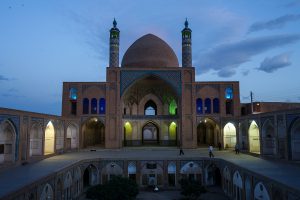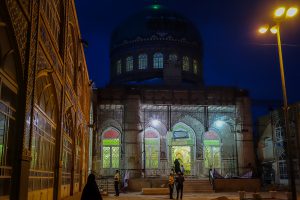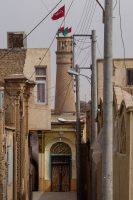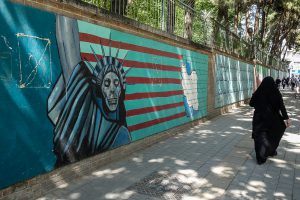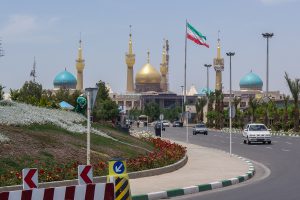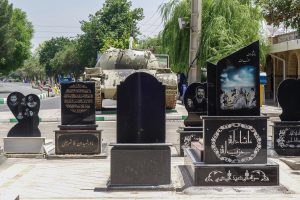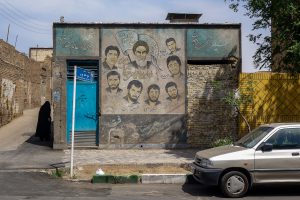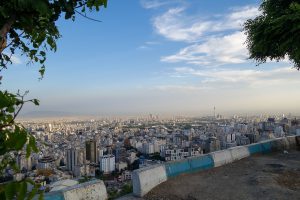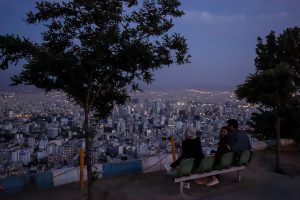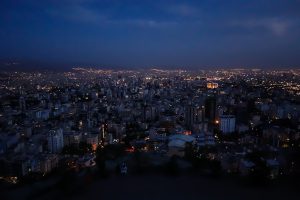Imam Khomeini Airport Teheran, kurz vor Sonnenaufgang, Uhr 4:25. Während die Maschine aus Katar langsam ausrollt, verwandeln sich die weiblichen Fluggäste blitzartig. Vorher nicht von den Passagieren eines beliebigen internationalen Fluges zu unterscheiden, werden sie nun zu Staatsbürgerinnen der islamischen Republik Iran: Zu körperbetonter Mode westlicher Labels, High-Heels und jeder Menge Make-up wird hastig aber routiniert der obligatorische, das Haar bedeckende Hidschab montiert… Mehr: nach unten scrollen!
English version
Imam Khomeini Airport Teheran, 4:25 a.m., just before sunrise: As the plane from Quatar taxies slowly to it’s parking position, the female passengers change quickly but routinely. Before, not to distinguish from the usual crowd on an international flight, they now become female citizens of the Islamic Republic of Iran. In addition to body emphasizing fashion of western brands, high heels and a lot of make-up, they now put on the obligatory hair covering hijab… Read more… scroll down!
Klick ein Foto an um die Fotogalerie zu starten!
- Martyrs
- Persepolis
- Persepolis
- Persepolis
- Persepolis
- Persepolis
Häufig stelle ich mir später die Frage, warum ein so einfaches Kleidungsstück, im Westen ein solches Unbehagen auslöst? Warum ist es ein so negatives Symbol für den Islam und dessen vermeintliche Rückständigkeit, für Unterdrückung oder religiöse Aggressivität? Auch meine Großmutter trug bei der Gartenarbeit ein Kopftuch. Doch auch ich spüre ein Unbehagen. Habe den Eindruck, dass ein Kopftuch aus einem jungen Mädchen eine alte Frau macht. Besonders in der schwarzen Variante, der Farbe, die bei uns für Tod, Trauer und Angst steht, ist es nicht gerade vertrauensbildend. In Teherans City allerdings gibt es reichlich Frauen, die offensichtlich auch nicht viel von der Kopftuchpflicht halten: Zu todschicker Kleidung wird ein transparentes Nichts von einem Hidschab getragen, provokant weit am Hinterkopf befestigt, so das Gesicht und Haare fast komplett freibleiben.
Im Iran existieren viele parallele Welten: Private Feiern auf denen der Wodka strömt neben tiefreligiösen Zeremonien. Arm – reich, weltlich – religiös. Gegensätze treffen aufeinander, leben aber auch miteinander – immer stolz auf Ihre Wurzeln und das kulturelle Erbe des Landes.
In Jahrhunderte alten Städten wie Shiraz, Kashan oder Isfahan mit chaotisch tobendem Straßenverkehr begegne ich der Architektur aus den „Isnogud“-Comics. Lehm- oder Ziegelgebäude, die gerade zu Staub zerfallen oder soeben neu errichtet werden. Die Altstädte sind geprägt von kubistischen, nicht allzu strengen Würfeln, die wild und wahllos aneinander geklebt scheinen – im Braun der Erde oder dem Gelb der Wüste. Darüber thronen monumentale melonen- oder zwiebelförmige Kuppeln, streichholzdünne Minarette, reich und farbenprächtig mit Mosaiken verziert, nachts von grün bis pink angestrahlt. Hundert Prozent Tausendundeine Nacht. Ein bizarres, aus der Zeit gefallenes Panorama, indem mich auch der Anblick eines fliegenden Teppichs nicht weiter überraschen würde. In den Labyrinthen der Basare, den Shopping-Malls aus der Vergangenheit, findet man den verschwunden geglaubten Bilderbuch-Orient mit all seinen Verführungen und Leckereien.
Daneben jedoch die ständige Konfrontation mit dem anderen Iran. Die Jungen und Gebildeten leiden unter der Perspektivlosigkeit – und wollen weg. Die Sehnsuchtsorte sind London, Melbourne, Paris oder Berlin. Mein Tischnachbar flüstert „Ich bin Atheist“ und erzählt mir, dass er allein für diese Aussage sterben könnte. Ein anderer, der mit seinen Freunden auf der Straße abhängt, entgegnet auf meine Frage, was er von seinem Land hält, wenig begeistert: „No bar, no music, no club“ und zuckt nur mit den Schultern. Kein Kommentar zur wenig toleranten Politik der Mullahs.
Die Herrschaft des Mullah-Regimes ist ein Produkt des Zufalls und einer fatalen Fehleinschätzung des Westens. Was sollte der alte Tattergreis Khomeini nach dem Sturz des Schahs schon anrichten können? Der Überfall auf die junge islamische Republik durch den Nachbardespoten Saddam Hussein hat die iranische Gesellschaft dann hinter Khomeini zusammengeschweißt. In einem unglaublich brutalen Krieg wurde sogar Giftgas – auch aus deutscher Produktion – eingesetzt. Kinder räumten Minenfelder, weil Esel und Maultiere zu schlau waren, sie zu betreten. Noch heute werden die Bilder der gefallenen Märtyrer überlebensgroß auf unzähligen Häuserfassaden gepinselt. Auf dem Behescht-e Zahrā (übers. „Paradies von Zahra“), dem zweitgrößten Friedhof der Welt im Süden Teherans, werden ihnen pompöse Denkmäler gesetzt. Gewürdigt werden dort aber auch Terroristen, die sich in den Cafés von Tel Aviv in die Luft gesprengt haben. In einem offenen Brief an „die westliche Jugend“, der in vielen Hotels aushängt, erklärt der aktuelle Revolutionsführe Khamenei der Jugend in Europa und Nordamerika im „Namen des mildtätigen, des gnädigen Gottes“ die Gründe für das Phänomen Terrorismus. Er erwähnt einerseits den ‚israelischen Staatsterrorismus‘ unter dem die Palästinenser seit 60 Jahren leiden, die von wirtschaftlichen Interessen geprägte Politik des Westens im Nahen und Mittleren Osten und führt die doppelten moralischen Standards der westlichen Welt an. Alles richtig, aber warum verurteilt Khamenei nicht auch ausdrücklich jeglichen Akt barbarischer Gewalt gegen unschuldige Zivilisten? Warum hat der Iran nach der Vertreibung der irakischen Invasoren noch jahrelang weiter Krieg geführt und seine Jugend geopfert?
Der Iran ist auch das Land der endlosen Gespräche mit Museumswächtern, Geschäftsleuten Restaurantbesitzern – eigentlich einfach jedem. Die Menschen sind, in einem im Westen unbekannten Maß, aufgeschlossen, ungemein freundlich, kultiviert und immer bemüht, Fremden das Land mit seiner uralten Kultur näher zu bringen. „Alle Menschen sind gut – Deutschland ist besser. Unsere Länder sind seit 500 Jahren Freunde“, behauptet ein Bazaari, der sich über seinen deutschen Gast freut. Und spielt damit auch auf in Deutschland längst vergessene Verhandlungen zwischen dem Nazi-Regime und dem Iran an. Deutschland hat mehrfach nicht ganz uneigennützige Hilfe angeboten, wenn es darum ging, im Mittleren Osten Engländern und Franzosen in die Suppe zu spucken. Stundenlang habe ich mit Zufallsbekanntschaften die Geschichte der letzten 50 Jahre diskutiert und in Kürze noch die 2500 Jahre davor abgehandelt. Die unrühmliche Rolle der CIA bei der Beseitigung des demokratisch gewählten Hoffnungsträgers Mossadegh, der dem Land die Herrschaft über seine Ölressourcen zurückgeben wollte. Die 400tägige Besetzung der amerikanischen Botschaft und die Geiselnahme der Mitarbeiter, die ohne diesen Coup der CIA nicht zu erklären sind. Die Fernsehbilder der besetzten Botschaft, die das Image des Iran für die nächsten Dekaden maßgeblich negativ geprägt haben.
Es bleibt der Eindruck, dass das Land weder Ost noch West ist. In meinen Gedanken drängen sich die gastfreundlichen Menschen in den Vordergrund, die fast immer auch eine Meinung zur Lage ihres Landes und zum Weltgeschehen haben. Der Iran wird mir als Land in Erinnerung bleiben, das für neugierige Reisende immer eine Überraschung und neue spannende Erfahrungen bereithält. In dem man sich stressfrei und sicher bewegen kann – abgesehen von den Outlaws hinterm Steuer, die den Straßenverkehr zu einem anarchistischen Tohuwabohu machen. Eine Fata Morgana frisch aus der Zeitmaschine, ein orientalischer Traum, rätselhaft, geheimnisvoll und unbedingt empfehlenswert!
English version
I ask myself, why such a simple piece of clothing leads to such an unease in the West. Why is it such a strong symbol for a supposed backwardly Islam, for suppression or religious aggressiveness? Even my grandma was wearing a scarf, when she was working in the garden. But me as well, I feel a little uncomfortable and have the impression, that a hijab turns a young girl into an old woman. Especially the black version, the color which stands for death, grief and anxiety in the West, appears not very confidence-building to me. In central Tehran, a lot of women not seem to like the hijab-duty so much. Amongst their posh clothing they wear a transparent nothing of a hijab, fixed provokingly at the back of the head, so that face and hair remain almost completely uncovered.
Many parallel societies exist in Iran. Private celebrations with a flow of vodka exist beside deeply religious ceremonies. Rich and poor, worldly and religious: Contradictions hit each other, but live with each other as well – always proud of the roots and the cultural heritage of the country. In ancient cities with horrific traffic you meet the architecture of the Iznogoud cartoons: Adobe- (clay-) or brick buildings, which crumble to dust or have been built just recently. The old towns are marked, by cubistic, not to strict blocks, which seem to stick together randomly – in the brownish tone of earth or the yellow color of the desert. Above that, the visitor sees minarets thin like toothpicks, rich and colorful decorated with mosaics, illuminated at night from green to pink. One hundred percent Thousand and One nights. Such a bizarre, out of time panorama, that I wouldn’t be surprised about a flying carpet. In the labyrinths of the bazaars, the shopping malls of the past, you find the supposedly disappeared orient of the coffee table books with all its delights and seductions.
But besides that, there is always the confrontation with the other Iran. The young and educated suffer from the lack of prospects. They want to leave. London, Melbourne, Paris or Berlin are the places they are longing for. A neighbor in a restaurant whispers to me„ I am an atheist” and remarks, that he could die for this statement alone. Another guy, spoiling time with his mates in the street, replies to my question about his opinion of the Iran: „No bar, no music, no club“, and shrugs his shoulders. No comment to the less permissive politics of the mullahs.
The regime of the mullahs is the result of coincidence and fatal misjudgment of the West. What kind of damage could the old dodderer Khomeini do after the fall of the Shah? Neighboring despot Saddam Hussein’s attack on the young Islamic Republic welded together the Iranian society behind Khomeini. In an unbelievable brutal war even toxic gas was used. Amongst others delivered of German companies. Children cleared minefields because donkeys were too smart to enter them. Still today the pictures of martyrs are painted larger than life on the walls of the streets everywhere. At Tehran’s giant central cemetery Behescht-e Zahrā („paradise of Zahra”) numberless monuments were erected for them. But the terrorists, who blow themselves up in the cafes of Tel Aviv, are honored here as well. The actual leader of the revolution Khamenei explains in a message to the „Youth in Europe and North America, in the name of Allah, the Beneficent the Merciful” the reasons for terrorism. He blames the Israeli state terrorism from which Palestine is suffering for the last 60 years, the politics of the West motivated by economic interests in the Middle East and the double moral standards of the West. Good arguments. But why doesn’t Khamenei condemn each act of barbarian violence against innocent citizens? Why did Iran continue the war against Iraq for six years after they chased the invaders out of their own country?
The Iran as well is the country of endless talks with museum wards, businessmen and restaurant owners – simply with everyone. The people are open-minded to an in the western world unknown extent, overwhelmingly friendly, cultivated and always strive to explain their country to strangers. „All people are good – Germans are better. Our countries have been friends for the last five hundred years”, declares a bazaari, who is happy about his German client. He hints at long forgotten negotiations between Nazi Germany and Iran. In the past Germany frequently offered selfish help, if it was about to rain on the parade of the British or French in the Middle East. For hours I discussed with randomly met people the history of the last fifty years and in a rush the 2500 years before: About the inglorious role of the CIA in the removing of democratic elected hope Mossadegh, who wanted to get back control of Iran’s natural resources. The four hundred days occupation of the US embassy and the hostage-taking of the staff can only be explained against the background of this CIA coup d’etat. The pictures of this hostage-taking on tv should shape the image of the Iran for the next three decades.
The impression remains, that the country is neither West nor East. In my remembrance the hospitable people with a precise opinion about the situation of their country and the world rush in the foreground. In my memory Iran will remain as a country of surprises and exciting experiences – where you can travel safe and stress-free with the exception of the outlaws behind the wheel who make traffic such a big anarchic hullabaloo. A fata morgana, an oriental dream out of a time machine, enigmatic, mysterious and absolutely recommendable!
